Comparative Law: Examining Legal Transplants, Methods, and Arguments
VerifiedAdded on 2022/11/27
|10
|2642
|434
Essay
AI Summary
This essay provides a comprehensive overview of comparative law, focusing on the functional method and legal transplants. It explores the debate surrounding the functional method, highlighting its proponents and critics, and delves into the complexities of legal institutions and political systems. The essay examines the arguments for and against legal transplants, considering their role in legal system transitions and reforms, and discusses the challenges associated with borrowing and implementing foreign laws. It analyzes the concept of path dependence and its impact on transplanting legal rules, while also providing insights into the essence and content of law, as well as the socio-political aspects of constitutional law. The essay concludes by emphasizing the dual nature of comparative law as both a method of scientific analysis and an independent legal science.
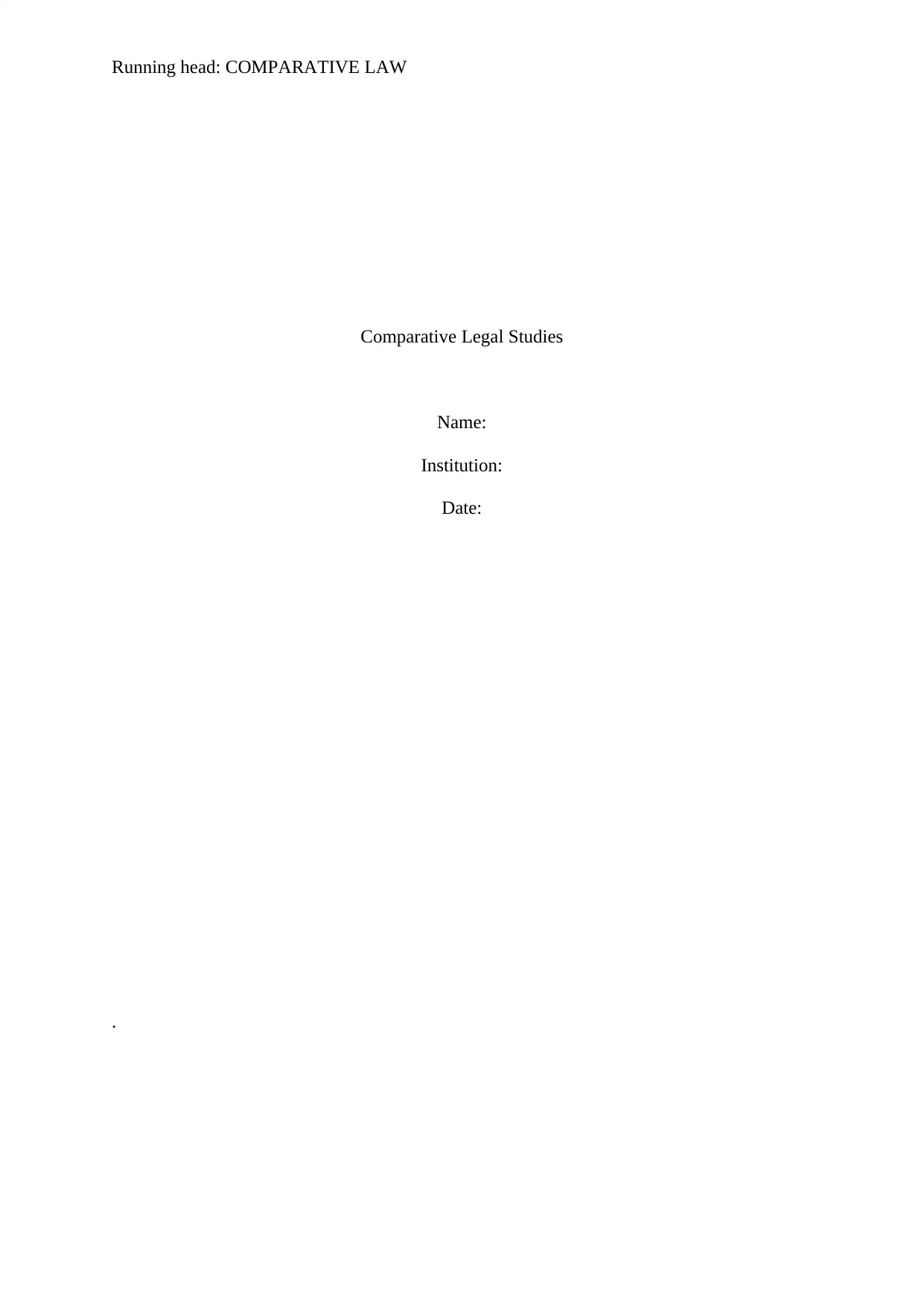
Running head: COMPARATIVE LAW
Comparative Legal Studies
Name:
Institution:
Date:
.
Comparative Legal Studies
Name:
Institution:
Date:
.
Paraphrase This Document
Need a fresh take? Get an instant paraphrase of this document with our AI Paraphraser
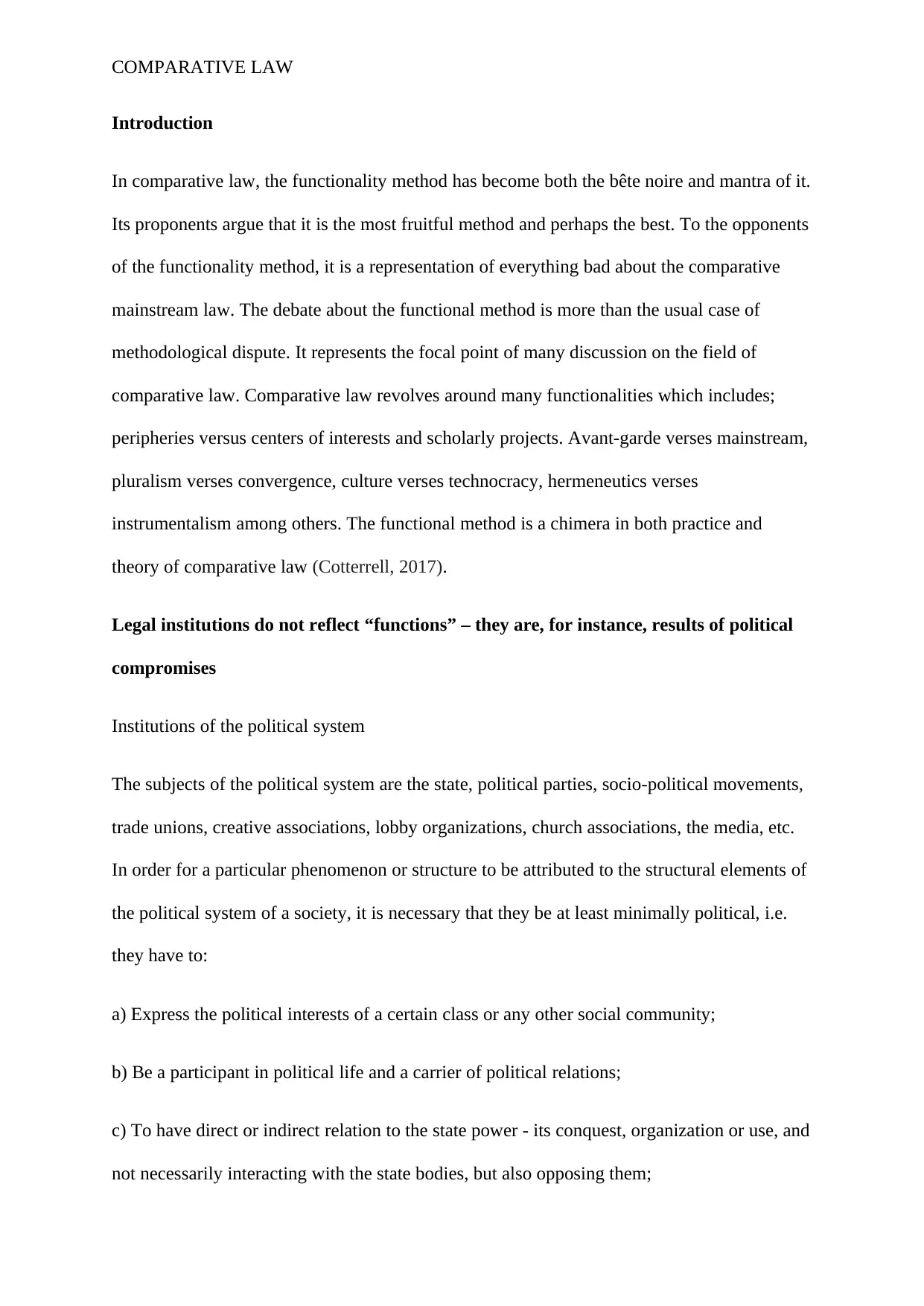
COMPARATIVE LAW
Introduction
In comparative law, the functionality method has become both the bête noire and mantra of it.
Its proponents argue that it is the most fruitful method and perhaps the best. To the opponents
of the functionality method, it is a representation of everything bad about the comparative
mainstream law. The debate about the functional method is more than the usual case of
methodological dispute. It represents the focal point of many discussion on the field of
comparative law. Comparative law revolves around many functionalities which includes;
peripheries versus centers of interests and scholarly projects. Avant-garde verses mainstream,
pluralism verses convergence, culture verses technocracy, hermeneutics verses
instrumentalism among others. The functional method is a chimera in both practice and
theory of comparative law (Cotterrell, 2017).
Legal institutions do not reflect “functions” – they are, for instance, results of political
compromises
Institutions of the political system
The subjects of the political system are the state, political parties, socio-political movements,
trade unions, creative associations, lobby organizations, church associations, the media, etc.
In order for a particular phenomenon or structure to be attributed to the structural elements of
the political system of a society, it is necessary that they be at least minimally political, i.e.
they have to:
a) Express the political interests of a certain class or any other social community;
b) Be a participant in political life and a carrier of political relations;
c) To have direct or indirect relation to the state power - its conquest, organization or use, and
not necessarily interacting with the state bodies, but also opposing them;
Introduction
In comparative law, the functionality method has become both the bête noire and mantra of it.
Its proponents argue that it is the most fruitful method and perhaps the best. To the opponents
of the functionality method, it is a representation of everything bad about the comparative
mainstream law. The debate about the functional method is more than the usual case of
methodological dispute. It represents the focal point of many discussion on the field of
comparative law. Comparative law revolves around many functionalities which includes;
peripheries versus centers of interests and scholarly projects. Avant-garde verses mainstream,
pluralism verses convergence, culture verses technocracy, hermeneutics verses
instrumentalism among others. The functional method is a chimera in both practice and
theory of comparative law (Cotterrell, 2017).
Legal institutions do not reflect “functions” – they are, for instance, results of political
compromises
Institutions of the political system
The subjects of the political system are the state, political parties, socio-political movements,
trade unions, creative associations, lobby organizations, church associations, the media, etc.
In order for a particular phenomenon or structure to be attributed to the structural elements of
the political system of a society, it is necessary that they be at least minimally political, i.e.
they have to:
a) Express the political interests of a certain class or any other social community;
b) Be a participant in political life and a carrier of political relations;
c) To have direct or indirect relation to the state power - its conquest, organization or use, and
not necessarily interacting with the state bodies, but also opposing them;
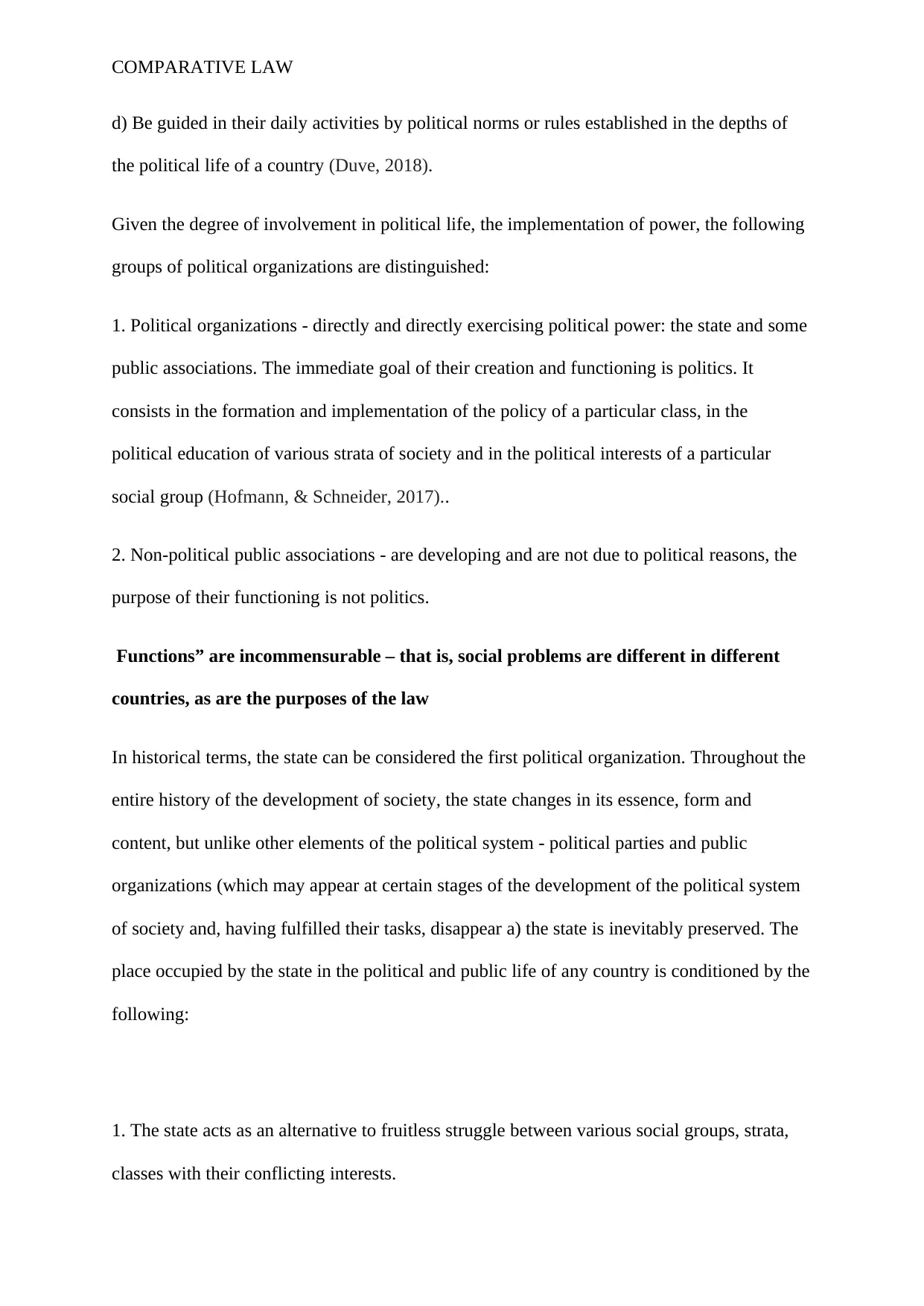
COMPARATIVE LAW
d) Be guided in their daily activities by political norms or rules established in the depths of
the political life of a country (Duve, 2018).
Given the degree of involvement in political life, the implementation of power, the following
groups of political organizations are distinguished:
1. Political organizations - directly and directly exercising political power: the state and some
public associations. The immediate goal of their creation and functioning is politics. It
consists in the formation and implementation of the policy of a particular class, in the
political education of various strata of society and in the political interests of a particular
social group (Hofmann, & Schneider, 2017)..
2. Non-political public associations - are developing and are not due to political reasons, the
purpose of their functioning is not politics.
Functions” are incommensurable – that is, social problems are different in different
countries, as are the purposes of the law
In historical terms, the state can be considered the first political organization. Throughout the
entire history of the development of society, the state changes in its essence, form and
content, but unlike other elements of the political system - political parties and public
organizations (which may appear at certain stages of the development of the political system
of society and, having fulfilled their tasks, disappear a) the state is inevitably preserved. The
place occupied by the state in the political and public life of any country is conditioned by the
following:
1. The state acts as an alternative to fruitless struggle between various social groups, strata,
classes with their conflicting interests.
d) Be guided in their daily activities by political norms or rules established in the depths of
the political life of a country (Duve, 2018).
Given the degree of involvement in political life, the implementation of power, the following
groups of political organizations are distinguished:
1. Political organizations - directly and directly exercising political power: the state and some
public associations. The immediate goal of their creation and functioning is politics. It
consists in the formation and implementation of the policy of a particular class, in the
political education of various strata of society and in the political interests of a particular
social group (Hofmann, & Schneider, 2017)..
2. Non-political public associations - are developing and are not due to political reasons, the
purpose of their functioning is not politics.
Functions” are incommensurable – that is, social problems are different in different
countries, as are the purposes of the law
In historical terms, the state can be considered the first political organization. Throughout the
entire history of the development of society, the state changes in its essence, form and
content, but unlike other elements of the political system - political parties and public
organizations (which may appear at certain stages of the development of the political system
of society and, having fulfilled their tasks, disappear a) the state is inevitably preserved. The
place occupied by the state in the political and public life of any country is conditioned by the
following:
1. The state acts as an alternative to fruitless struggle between various social groups, strata,
classes with their conflicting interests.
⊘ This is a preview!⊘
Do you want full access?
Subscribe today to unlock all pages.

Trusted by 1+ million students worldwide
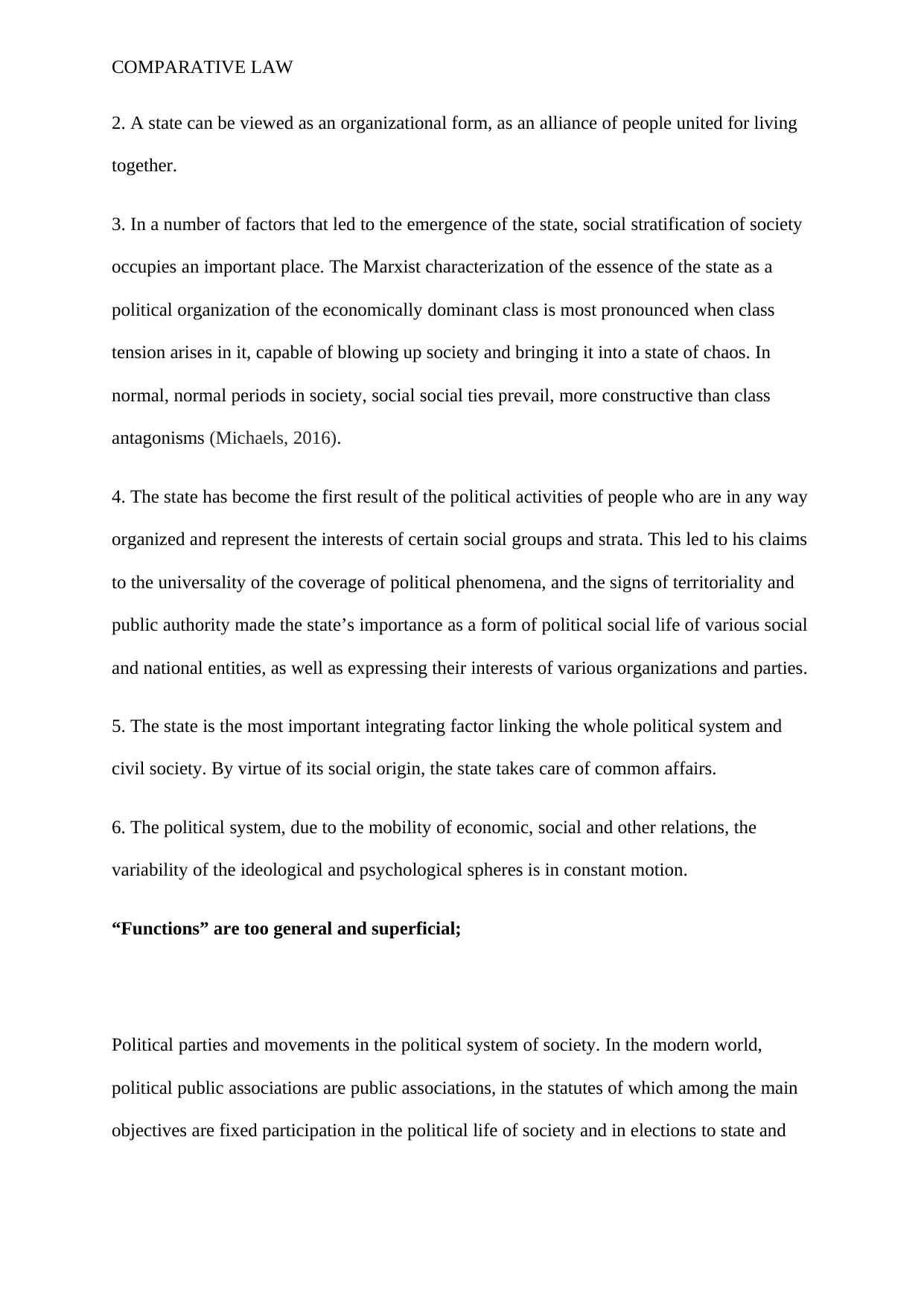
COMPARATIVE LAW
2. A state can be viewed as an organizational form, as an alliance of people united for living
together.
3. In a number of factors that led to the emergence of the state, social stratification of society
occupies an important place. The Marxist characterization of the essence of the state as a
political organization of the economically dominant class is most pronounced when class
tension arises in it, capable of blowing up society and bringing it into a state of chaos. In
normal, normal periods in society, social social ties prevail, more constructive than class
antagonisms (Michaels, 2016).
4. The state has become the first result of the political activities of people who are in any way
organized and represent the interests of certain social groups and strata. This led to his claims
to the universality of the coverage of political phenomena, and the signs of territoriality and
public authority made the state’s importance as a form of political social life of various social
and national entities, as well as expressing their interests of various organizations and parties.
5. The state is the most important integrating factor linking the whole political system and
civil society. By virtue of its social origin, the state takes care of common affairs.
6. The political system, due to the mobility of economic, social and other relations, the
variability of the ideological and psychological spheres is in constant motion.
“Functions” are too general and superficial;
Political parties and movements in the political system of society. In the modern world,
political public associations are public associations, in the statutes of which among the main
objectives are fixed participation in the political life of society and in elections to state and
2. A state can be viewed as an organizational form, as an alliance of people united for living
together.
3. In a number of factors that led to the emergence of the state, social stratification of society
occupies an important place. The Marxist characterization of the essence of the state as a
political organization of the economically dominant class is most pronounced when class
tension arises in it, capable of blowing up society and bringing it into a state of chaos. In
normal, normal periods in society, social social ties prevail, more constructive than class
antagonisms (Michaels, 2016).
4. The state has become the first result of the political activities of people who are in any way
organized and represent the interests of certain social groups and strata. This led to his claims
to the universality of the coverage of political phenomena, and the signs of territoriality and
public authority made the state’s importance as a form of political social life of various social
and national entities, as well as expressing their interests of various organizations and parties.
5. The state is the most important integrating factor linking the whole political system and
civil society. By virtue of its social origin, the state takes care of common affairs.
6. The political system, due to the mobility of economic, social and other relations, the
variability of the ideological and psychological spheres is in constant motion.
“Functions” are too general and superficial;
Political parties and movements in the political system of society. In the modern world,
political public associations are public associations, in the statutes of which among the main
objectives are fixed participation in the political life of society and in elections to state and
Paraphrase This Document
Need a fresh take? Get an instant paraphrase of this document with our AI Paraphraser
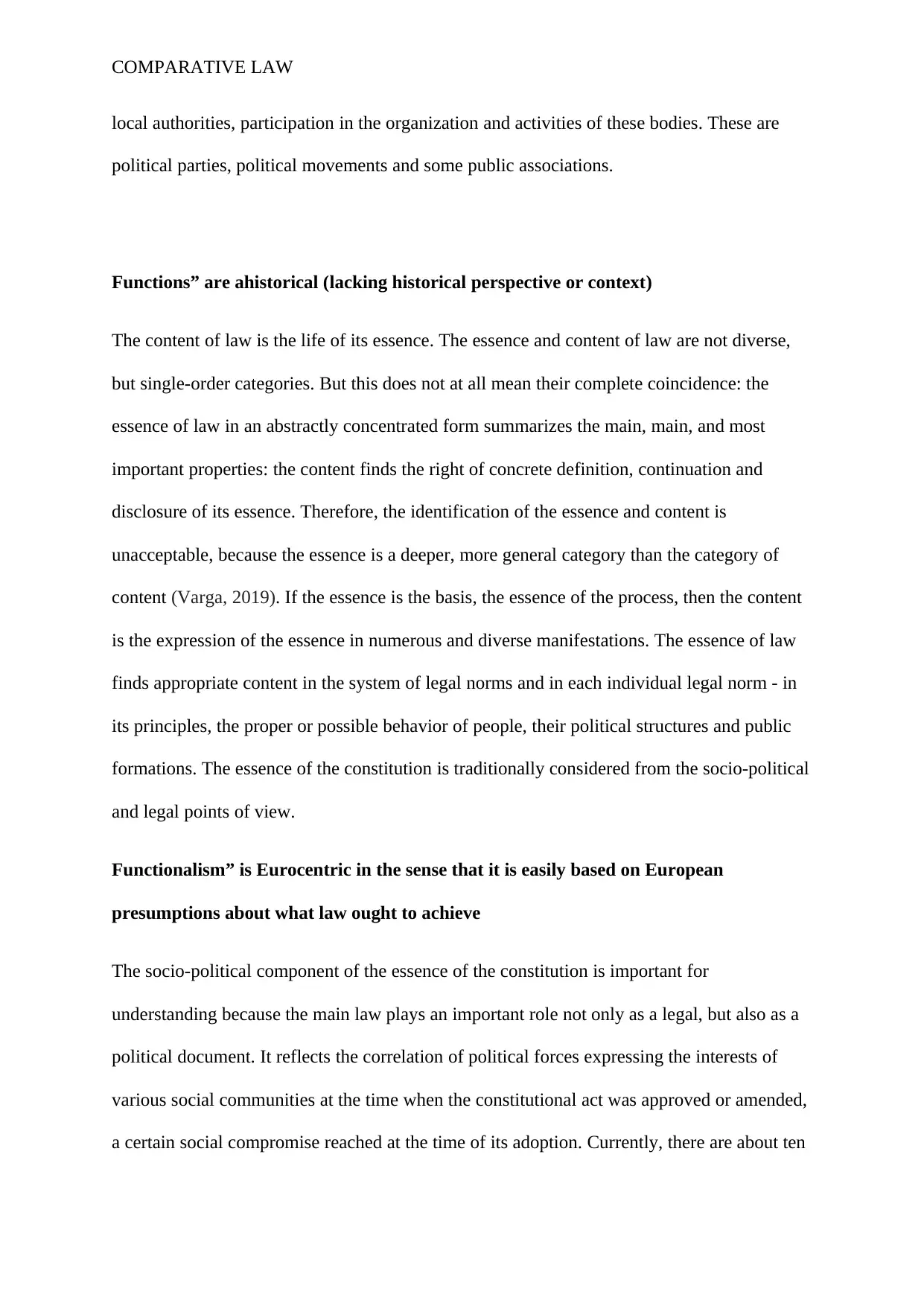
COMPARATIVE LAW
local authorities, participation in the organization and activities of these bodies. These are
political parties, political movements and some public associations.
Functions” are ahistorical (lacking historical perspective or context)
The content of law is the life of its essence. The essence and content of law are not diverse,
but single-order categories. But this does not at all mean their complete coincidence: the
essence of law in an abstractly concentrated form summarizes the main, main, and most
important properties: the content finds the right of concrete definition, continuation and
disclosure of its essence. Therefore, the identification of the essence and content is
unacceptable, because the essence is a deeper, more general category than the category of
content (Varga, 2019). If the essence is the basis, the essence of the process, then the content
is the expression of the essence in numerous and diverse manifestations. The essence of law
finds appropriate content in the system of legal norms and in each individual legal norm - in
its principles, the proper or possible behavior of people, their political structures and public
formations. The essence of the constitution is traditionally considered from the socio-political
and legal points of view.
Functionalism” is Eurocentric in the sense that it is easily based on European
presumptions about what law ought to achieve
The socio-political component of the essence of the constitution is important for
understanding because the main law plays an important role not only as a legal, but also as a
political document. It reflects the correlation of political forces expressing the interests of
various social communities at the time when the constitutional act was approved or amended,
a certain social compromise reached at the time of its adoption. Currently, there are about ten
local authorities, participation in the organization and activities of these bodies. These are
political parties, political movements and some public associations.
Functions” are ahistorical (lacking historical perspective or context)
The content of law is the life of its essence. The essence and content of law are not diverse,
but single-order categories. But this does not at all mean their complete coincidence: the
essence of law in an abstractly concentrated form summarizes the main, main, and most
important properties: the content finds the right of concrete definition, continuation and
disclosure of its essence. Therefore, the identification of the essence and content is
unacceptable, because the essence is a deeper, more general category than the category of
content (Varga, 2019). If the essence is the basis, the essence of the process, then the content
is the expression of the essence in numerous and diverse manifestations. The essence of law
finds appropriate content in the system of legal norms and in each individual legal norm - in
its principles, the proper or possible behavior of people, their political structures and public
formations. The essence of the constitution is traditionally considered from the socio-political
and legal points of view.
Functionalism” is Eurocentric in the sense that it is easily based on European
presumptions about what law ought to achieve
The socio-political component of the essence of the constitution is important for
understanding because the main law plays an important role not only as a legal, but also as a
political document. It reflects the correlation of political forces expressing the interests of
various social communities at the time when the constitutional act was approved or amended,
a certain social compromise reached at the time of its adoption. Currently, there are about ten
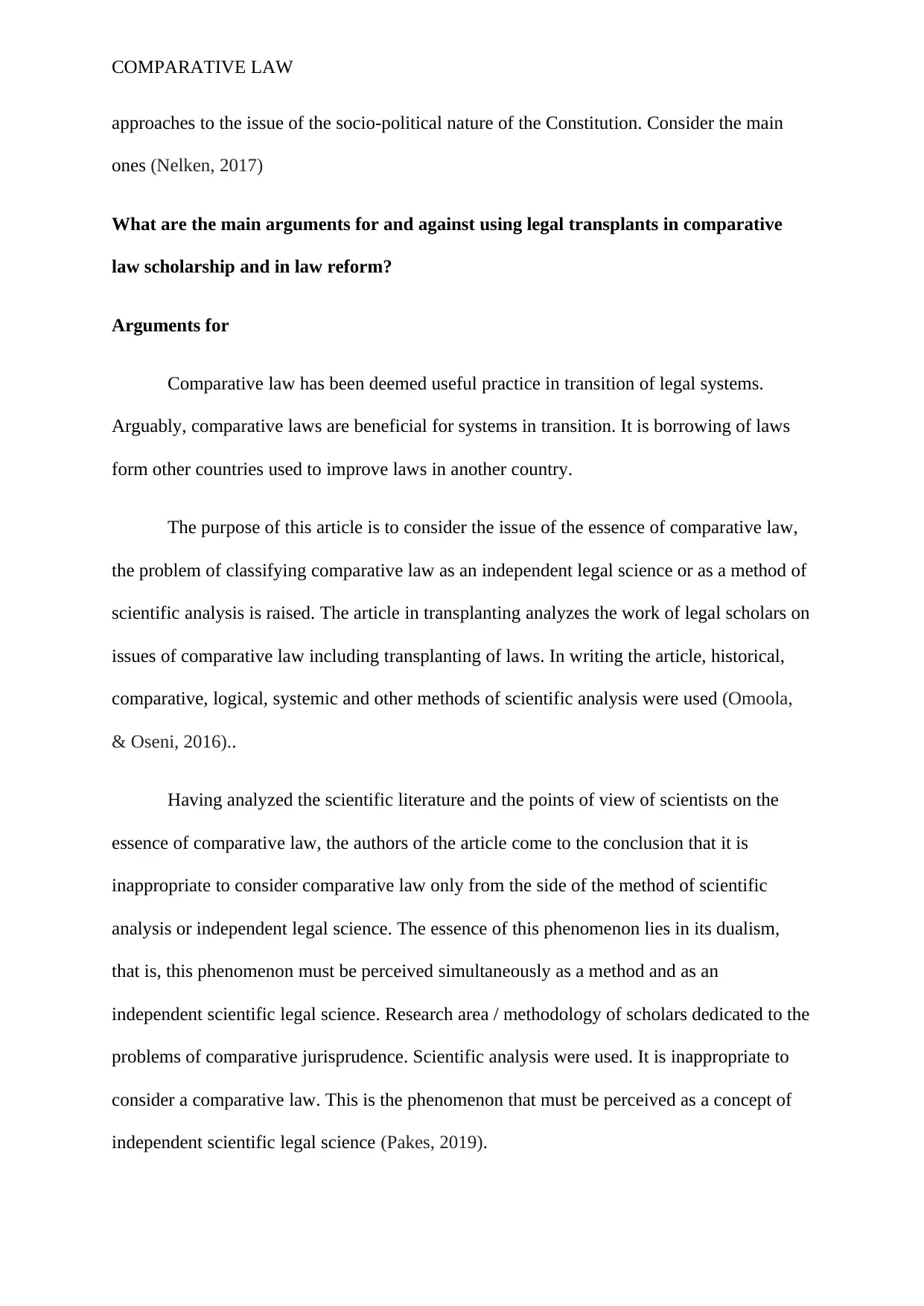
COMPARATIVE LAW
approaches to the issue of the socio-political nature of the Constitution. Consider the main
ones (Nelken, 2017)
What are the main arguments for and against using legal transplants in comparative
law scholarship and in law reform?
Arguments for
Comparative law has been deemed useful practice in transition of legal systems.
Arguably, comparative laws are beneficial for systems in transition. It is borrowing of laws
form other countries used to improve laws in another country.
The purpose of this article is to consider the issue of the essence of comparative law,
the problem of classifying comparative law as an independent legal science or as a method of
scientific analysis is raised. The article in transplanting analyzes the work of legal scholars on
issues of comparative law including transplanting of laws. In writing the article, historical,
comparative, logical, systemic and other methods of scientific analysis were used (Omoola,
& Oseni, 2016)..
Having analyzed the scientific literature and the points of view of scientists on the
essence of comparative law, the authors of the article come to the conclusion that it is
inappropriate to consider comparative law only from the side of the method of scientific
analysis or independent legal science. The essence of this phenomenon lies in its dualism,
that is, this phenomenon must be perceived simultaneously as a method and as an
independent scientific legal science. Research area / methodology of scholars dedicated to the
problems of comparative jurisprudence. Scientific analysis were used. It is inappropriate to
consider a comparative law. This is the phenomenon that must be perceived as a concept of
independent scientific legal science (Pakes, 2019).
approaches to the issue of the socio-political nature of the Constitution. Consider the main
ones (Nelken, 2017)
What are the main arguments for and against using legal transplants in comparative
law scholarship and in law reform?
Arguments for
Comparative law has been deemed useful practice in transition of legal systems.
Arguably, comparative laws are beneficial for systems in transition. It is borrowing of laws
form other countries used to improve laws in another country.
The purpose of this article is to consider the issue of the essence of comparative law,
the problem of classifying comparative law as an independent legal science or as a method of
scientific analysis is raised. The article in transplanting analyzes the work of legal scholars on
issues of comparative law including transplanting of laws. In writing the article, historical,
comparative, logical, systemic and other methods of scientific analysis were used (Omoola,
& Oseni, 2016)..
Having analyzed the scientific literature and the points of view of scientists on the
essence of comparative law, the authors of the article come to the conclusion that it is
inappropriate to consider comparative law only from the side of the method of scientific
analysis or independent legal science. The essence of this phenomenon lies in its dualism,
that is, this phenomenon must be perceived simultaneously as a method and as an
independent scientific legal science. Research area / methodology of scholars dedicated to the
problems of comparative jurisprudence. Scientific analysis were used. It is inappropriate to
consider a comparative law. This is the phenomenon that must be perceived as a concept of
independent scientific legal science (Pakes, 2019).
⊘ This is a preview!⊘
Do you want full access?
Subscribe today to unlock all pages.

Trusted by 1+ million students worldwide
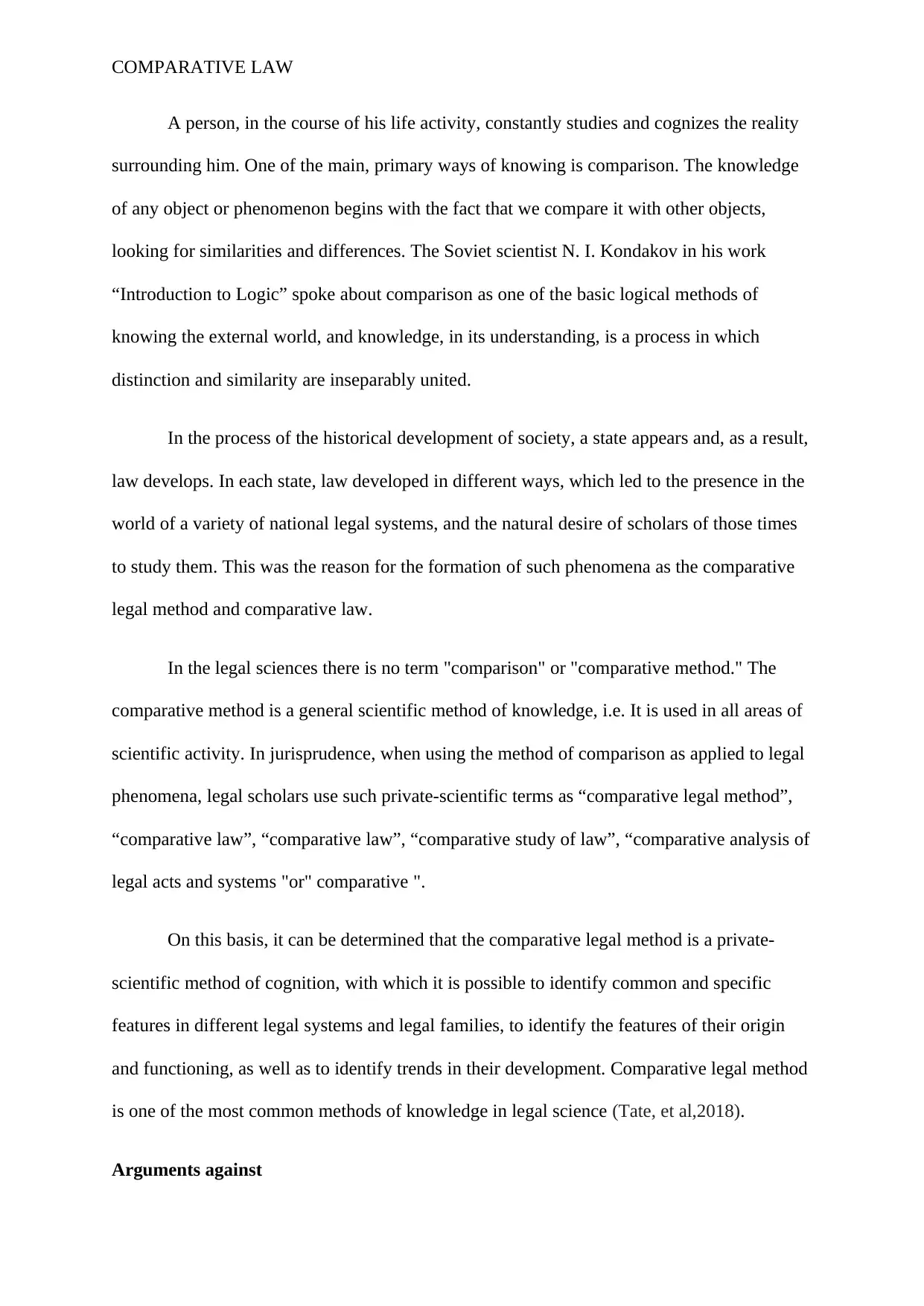
COMPARATIVE LAW
A person, in the course of his life activity, constantly studies and cognizes the reality
surrounding him. One of the main, primary ways of knowing is comparison. The knowledge
of any object or phenomenon begins with the fact that we compare it with other objects,
looking for similarities and differences. The Soviet scientist N. I. Kondakov in his work
“Introduction to Logic” spoke about comparison as one of the basic logical methods of
knowing the external world, and knowledge, in its understanding, is a process in which
distinction and similarity are inseparably united.
In the process of the historical development of society, a state appears and, as a result,
law develops. In each state, law developed in different ways, which led to the presence in the
world of a variety of national legal systems, and the natural desire of scholars of those times
to study them. This was the reason for the formation of such phenomena as the comparative
legal method and comparative law.
In the legal sciences there is no term "comparison" or "comparative method." The
comparative method is a general scientific method of knowledge, i.e. It is used in all areas of
scientific activity. In jurisprudence, when using the method of comparison as applied to legal
phenomena, legal scholars use such private-scientific terms as “comparative legal method”,
“comparative law”, “comparative law”, “comparative study of law”, “comparative analysis of
legal acts and systems "or" comparative ".
On this basis, it can be determined that the comparative legal method is a private-
scientific method of cognition, with which it is possible to identify common and specific
features in different legal systems and legal families, to identify the features of their origin
and functioning, as well as to identify trends in their development. Comparative legal method
is one of the most common methods of knowledge in legal science (Tate, et al,2018).
Arguments against
A person, in the course of his life activity, constantly studies and cognizes the reality
surrounding him. One of the main, primary ways of knowing is comparison. The knowledge
of any object or phenomenon begins with the fact that we compare it with other objects,
looking for similarities and differences. The Soviet scientist N. I. Kondakov in his work
“Introduction to Logic” spoke about comparison as one of the basic logical methods of
knowing the external world, and knowledge, in its understanding, is a process in which
distinction and similarity are inseparably united.
In the process of the historical development of society, a state appears and, as a result,
law develops. In each state, law developed in different ways, which led to the presence in the
world of a variety of national legal systems, and the natural desire of scholars of those times
to study them. This was the reason for the formation of such phenomena as the comparative
legal method and comparative law.
In the legal sciences there is no term "comparison" or "comparative method." The
comparative method is a general scientific method of knowledge, i.e. It is used in all areas of
scientific activity. In jurisprudence, when using the method of comparison as applied to legal
phenomena, legal scholars use such private-scientific terms as “comparative legal method”,
“comparative law”, “comparative law”, “comparative study of law”, “comparative analysis of
legal acts and systems "or" comparative ".
On this basis, it can be determined that the comparative legal method is a private-
scientific method of cognition, with which it is possible to identify common and specific
features in different legal systems and legal families, to identify the features of their origin
and functioning, as well as to identify trends in their development. Comparative legal method
is one of the most common methods of knowledge in legal science (Tate, et al,2018).
Arguments against
Paraphrase This Document
Need a fresh take? Get an instant paraphrase of this document with our AI Paraphraser
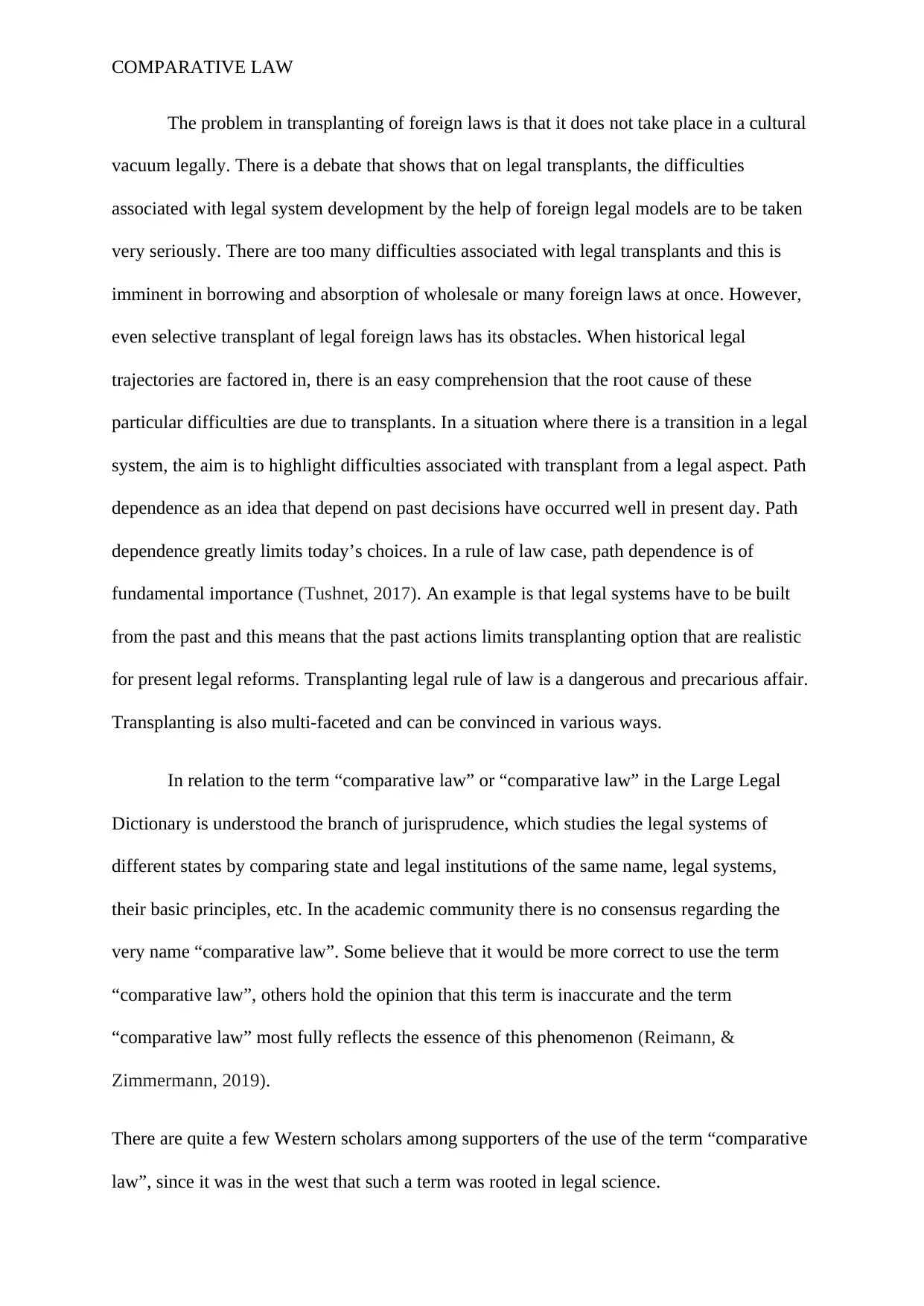
COMPARATIVE LAW
The problem in transplanting of foreign laws is that it does not take place in a cultural
vacuum legally. There is a debate that shows that on legal transplants, the difficulties
associated with legal system development by the help of foreign legal models are to be taken
very seriously. There are too many difficulties associated with legal transplants and this is
imminent in borrowing and absorption of wholesale or many foreign laws at once. However,
even selective transplant of legal foreign laws has its obstacles. When historical legal
trajectories are factored in, there is an easy comprehension that the root cause of these
particular difficulties are due to transplants. In a situation where there is a transition in a legal
system, the aim is to highlight difficulties associated with transplant from a legal aspect. Path
dependence as an idea that depend on past decisions have occurred well in present day. Path
dependence greatly limits today’s choices. In a rule of law case, path dependence is of
fundamental importance (Tushnet, 2017). An example is that legal systems have to be built
from the past and this means that the past actions limits transplanting option that are realistic
for present legal reforms. Transplanting legal rule of law is a dangerous and precarious affair.
Transplanting is also multi-faceted and can be convinced in various ways.
In relation to the term “comparative law” or “comparative law” in the Large Legal
Dictionary is understood the branch of jurisprudence, which studies the legal systems of
different states by comparing state and legal institutions of the same name, legal systems,
their basic principles, etc. In the academic community there is no consensus regarding the
very name “comparative law”. Some believe that it would be more correct to use the term
“comparative law”, others hold the opinion that this term is inaccurate and the term
“comparative law” most fully reflects the essence of this phenomenon (Reimann, &
Zimmermann, 2019).
There are quite a few Western scholars among supporters of the use of the term “comparative
law”, since it was in the west that such a term was rooted in legal science.
The problem in transplanting of foreign laws is that it does not take place in a cultural
vacuum legally. There is a debate that shows that on legal transplants, the difficulties
associated with legal system development by the help of foreign legal models are to be taken
very seriously. There are too many difficulties associated with legal transplants and this is
imminent in borrowing and absorption of wholesale or many foreign laws at once. However,
even selective transplant of legal foreign laws has its obstacles. When historical legal
trajectories are factored in, there is an easy comprehension that the root cause of these
particular difficulties are due to transplants. In a situation where there is a transition in a legal
system, the aim is to highlight difficulties associated with transplant from a legal aspect. Path
dependence as an idea that depend on past decisions have occurred well in present day. Path
dependence greatly limits today’s choices. In a rule of law case, path dependence is of
fundamental importance (Tushnet, 2017). An example is that legal systems have to be built
from the past and this means that the past actions limits transplanting option that are realistic
for present legal reforms. Transplanting legal rule of law is a dangerous and precarious affair.
Transplanting is also multi-faceted and can be convinced in various ways.
In relation to the term “comparative law” or “comparative law” in the Large Legal
Dictionary is understood the branch of jurisprudence, which studies the legal systems of
different states by comparing state and legal institutions of the same name, legal systems,
their basic principles, etc. In the academic community there is no consensus regarding the
very name “comparative law”. Some believe that it would be more correct to use the term
“comparative law”, others hold the opinion that this term is inaccurate and the term
“comparative law” most fully reflects the essence of this phenomenon (Reimann, &
Zimmermann, 2019).
There are quite a few Western scholars among supporters of the use of the term “comparative
law”, since it was in the west that such a term was rooted in legal science.
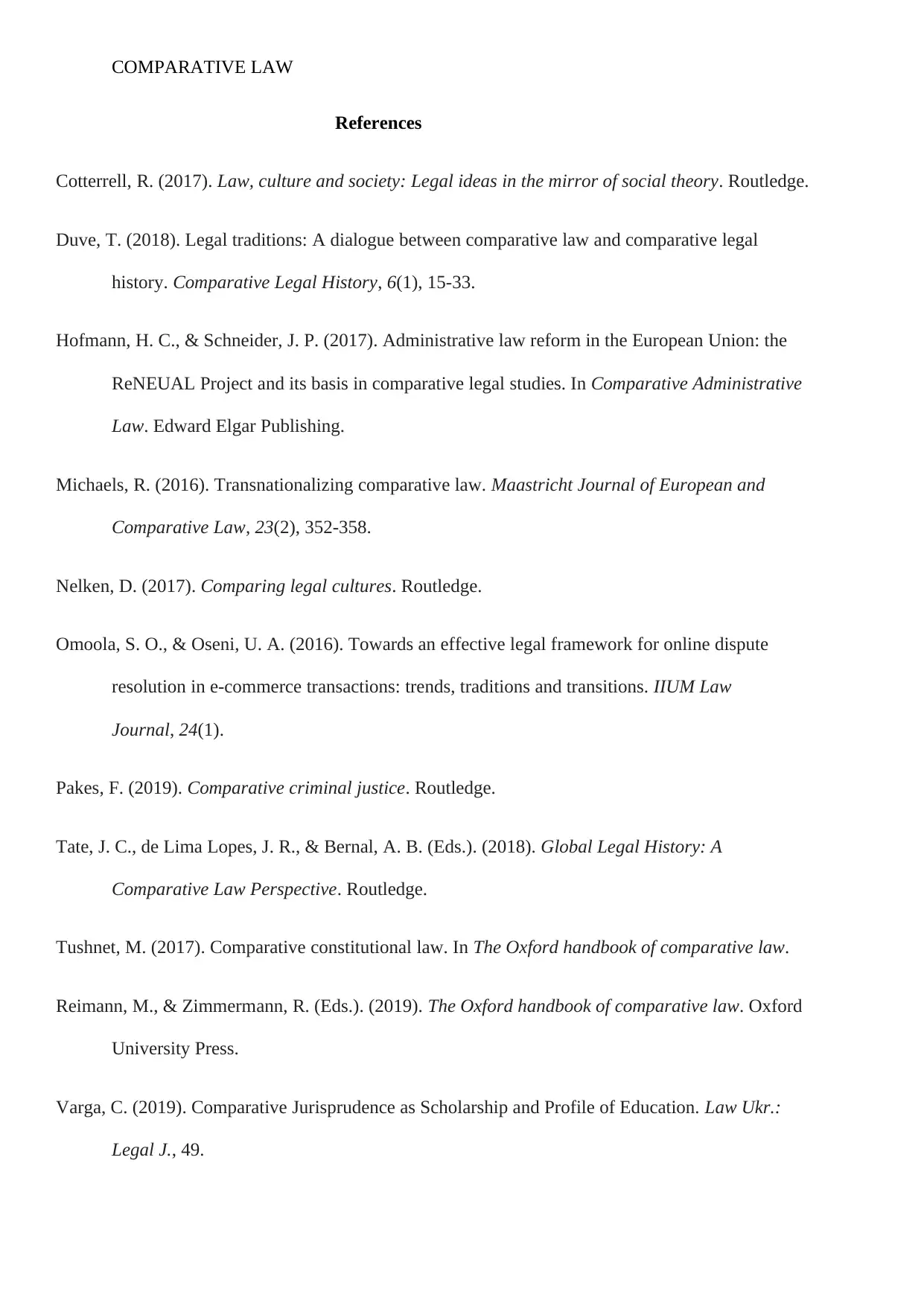
COMPARATIVE LAW
References
Cotterrell, R. (2017). Law, culture and society: Legal ideas in the mirror of social theory. Routledge.
Duve, T. (2018). Legal traditions: A dialogue between comparative law and comparative legal
history. Comparative Legal History, 6(1), 15-33.
Hofmann, H. C., & Schneider, J. P. (2017). Administrative law reform in the European Union: the
ReNEUAL Project and its basis in comparative legal studies. In Comparative Administrative
Law. Edward Elgar Publishing.
Michaels, R. (2016). Transnationalizing comparative law. Maastricht Journal of European and
Comparative Law, 23(2), 352-358.
Nelken, D. (2017). Comparing legal cultures. Routledge.
Omoola, S. O., & Oseni, U. A. (2016). Towards an effective legal framework for online dispute
resolution in e-commerce transactions: trends, traditions and transitions. IIUM Law
Journal, 24(1).
Pakes, F. (2019). Comparative criminal justice. Routledge.
Tate, J. C., de Lima Lopes, J. R., & Bernal, A. B. (Eds.). (2018). Global Legal History: A
Comparative Law Perspective. Routledge.
Tushnet, M. (2017). Comparative constitutional law. In The Oxford handbook of comparative law.
Reimann, M., & Zimmermann, R. (Eds.). (2019). The Oxford handbook of comparative law. Oxford
University Press.
Varga, C. (2019). Comparative Jurisprudence as Scholarship and Profile of Education. Law Ukr.:
Legal J., 49.
References
Cotterrell, R. (2017). Law, culture and society: Legal ideas in the mirror of social theory. Routledge.
Duve, T. (2018). Legal traditions: A dialogue between comparative law and comparative legal
history. Comparative Legal History, 6(1), 15-33.
Hofmann, H. C., & Schneider, J. P. (2017). Administrative law reform in the European Union: the
ReNEUAL Project and its basis in comparative legal studies. In Comparative Administrative
Law. Edward Elgar Publishing.
Michaels, R. (2016). Transnationalizing comparative law. Maastricht Journal of European and
Comparative Law, 23(2), 352-358.
Nelken, D. (2017). Comparing legal cultures. Routledge.
Omoola, S. O., & Oseni, U. A. (2016). Towards an effective legal framework for online dispute
resolution in e-commerce transactions: trends, traditions and transitions. IIUM Law
Journal, 24(1).
Pakes, F. (2019). Comparative criminal justice. Routledge.
Tate, J. C., de Lima Lopes, J. R., & Bernal, A. B. (Eds.). (2018). Global Legal History: A
Comparative Law Perspective. Routledge.
Tushnet, M. (2017). Comparative constitutional law. In The Oxford handbook of comparative law.
Reimann, M., & Zimmermann, R. (Eds.). (2019). The Oxford handbook of comparative law. Oxford
University Press.
Varga, C. (2019). Comparative Jurisprudence as Scholarship and Profile of Education. Law Ukr.:
Legal J., 49.
⊘ This is a preview!⊘
Do you want full access?
Subscribe today to unlock all pages.

Trusted by 1+ million students worldwide

COMPARATIVE LAW
1 out of 10
Related Documents
Your All-in-One AI-Powered Toolkit for Academic Success.
+13062052269
info@desklib.com
Available 24*7 on WhatsApp / Email
![[object Object]](/_next/static/media/star-bottom.7253800d.svg)
Unlock your academic potential
Copyright © 2020–2025 A2Z Services. All Rights Reserved. Developed and managed by ZUCOL.





